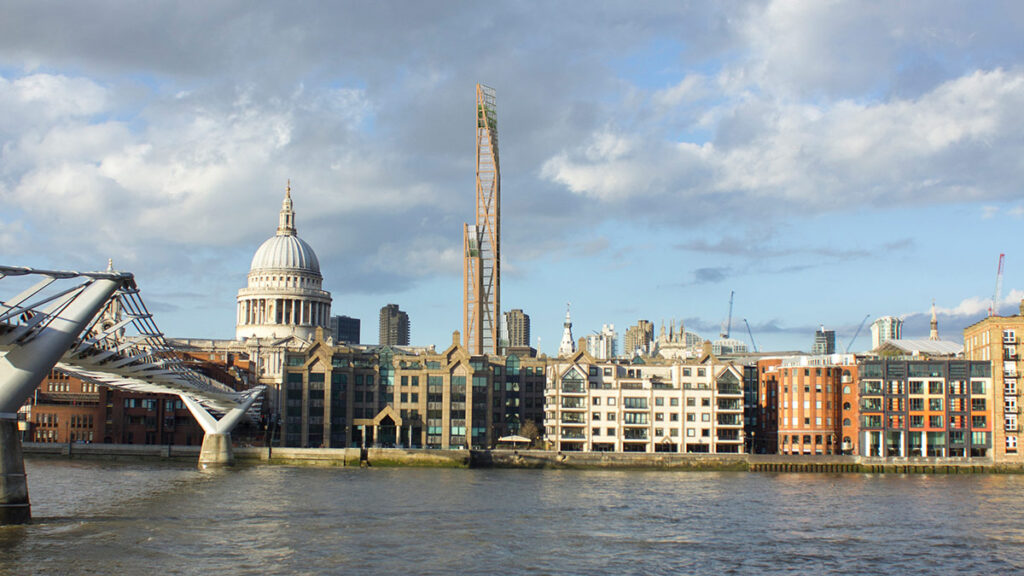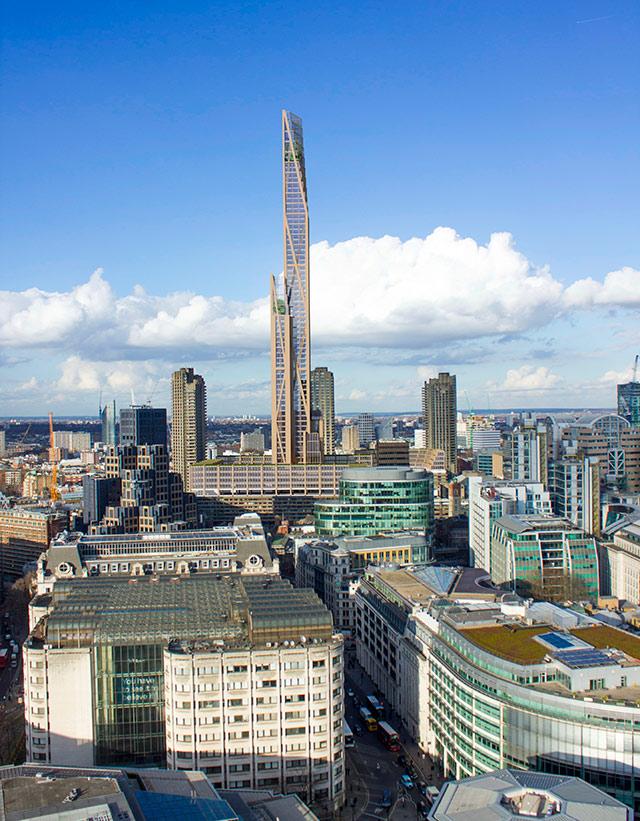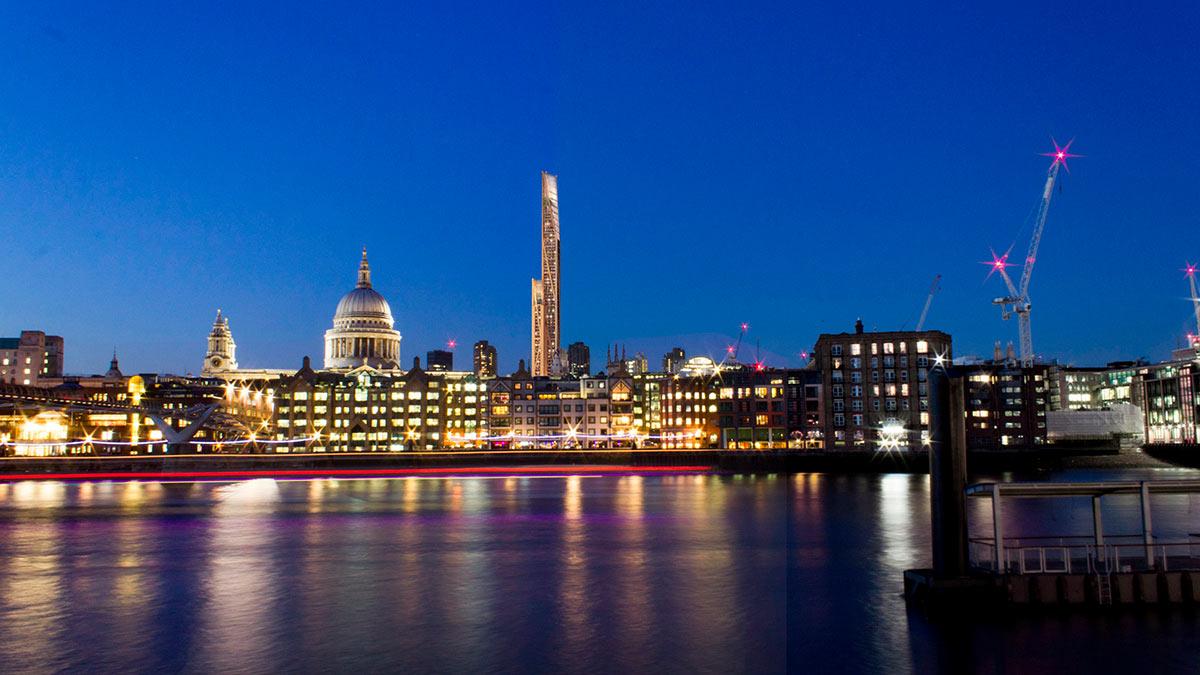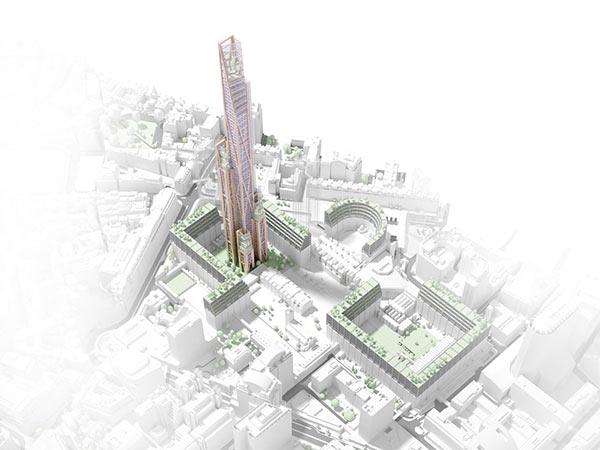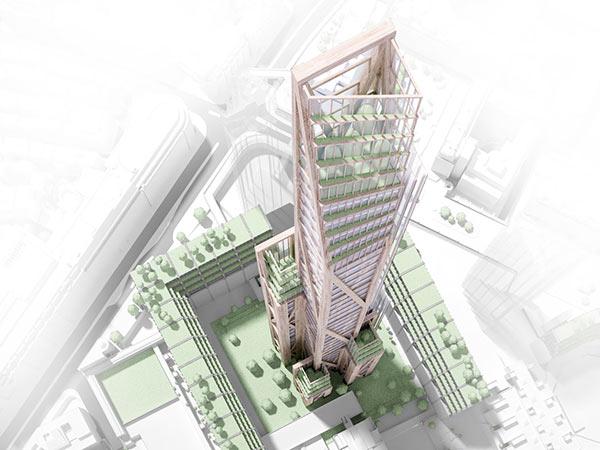Wood on London’s skyline
Researchers at Cambridge University are helping to turn London’s spectacular vision of a wooden skyscraper into reality. The Oakwood Timber Tower is to rise 300 metres into the sky, almost level with the tallest building in the city.
The intended location couldn’t be more symbolic. In the centre of London’s Barbican Estate, a Grade II listed concrete residential complex, a new skyscraper is to be largely constructed of wood. A timber spearhead of sustainable architecture rising up from the CO₂-profligate brutalist legacy. It’s about as metaphorical as it gets. The conceptual design for the Oakwood Timber Tower, which is intended as a residential development, was created by PLP Architecture in collaboration with the University of Cambridge’s Centre for Natural Material Innovation.
Anyone already looking forward to the view of the surrounding skyscrapers from London’s new plyscraper will have to curb their excitement, however. The project is currently still in the research stage. An interdisciplinary team of scientists, engineers and architects is working feverishly to investigate the feasibility of the gigantic wooden tower. They are conducting research at all levels – from the microscopic cell structure of the wood to the ability of the high-rise to withstand strong winds.
A renaissance in timber construction
The research group has tasked itself with promoting the use of wood as the main construction material for high-rise structures. Experts around the world are currently looking to this renewable resource as the building material of the future. Besides its ability to bind CO₂ while growing, wood has exceptional material properties and a low self-weight. The high degree of prefabrication reduces construction time as well.
Cross-laminated timber modular panels can often be built in a third of the time, with far fewer hands and significantly less noise than concrete elements.
Kevin Flanagan, PLP Architecture
While Berlin’s WoHo and Eindhoven’s Dutch Mountains are set to break the 100-metre mark for a timber construction, the goals for the new addition to London’s skyline are far more ambitious. With a planned height of 300 metres, the Oakwood Timber Tower is just a shade under that of the Shard. This 310-metre tower designed by architect Renzo Piano is currently the tallest skyscraper in London and became the tallest building in the European Union.
Breakthrough thanks to cross-laminated timber
The key to high-rise wooden construction is cross-laminated timber, or CLT for short. The development of suitable products has gained momentum since the 1990s. Austria and Germany rank among the most important European producers and exporters in what is a huge growth market.
“Cross-laminated timber modular panels can often be built in a third of the time, with far fewer hands and significantly less noise than concrete elements,” emphasizes Kevin Flanagan, lead architect of the Oakwood Timber Tower project. The low weight of wood offers enormous advantages when it comes to urban development.
A timber building by nature is very light, requiring less deep foundations. This means that they are ideal for sites in big cities.
Kevin Flanagan, PLP Architecture
Advantages of lightweight construction
“Timber buildings by nature are very light, requiring less deep foundations. This means that they are ideal for sites that sit on top of underground infrastructure such as tunnels that are very common in big cities,” continues Kevin Flanagan. When constructed out of wood, the weight of the tower is roughly a quarter that of a similar structure made from reinforced concrete.
Flanagan points to the findings of recent studies to rebut the repeatedly raised concerns regarding the fire safety of wooden high-rises. The way the timber tower is designed, it would more than fulfil current fire safety regulations. “Cross-lamination establishes a new level of quality control and fire protection. It brings a new structure and form,” explains Flanagan.
A new dimension in urban development
For the architects, the construction of wooden skyscrapers represents the dawn of a new era. “Just as major innovations in steel, glass, concrete revolutionised buildings in the 19th and 20th centuries, innovations in timber construction could lead to entirely new experiences of the city in the 21st century.”
PLP Architecture is a global player in the construction industry and has already produced the tallest low-energy skyscraper in the world with the 22 Bishopsgate project. By constructing the Oakwood Timber Tower on the site of the Barbican in London, the architects are seeking to reconcile the now sentimentally regarded “concrete brute” of yesteryear with the visionary timber construction of the future.
Text: Gertraud Gerst
Images: PLP Architecture
